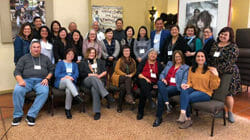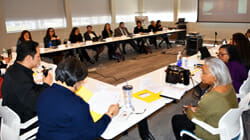The Minidoka Pilgrimage: An American story for times such as these

“American Citizens,” Acrylic, 24 x 34, 2015, by Roger Shimomura
By Susan Gottshall
The gray baseball cap and blue polo shirt were rather unremarkable, but the white Kleenex spoke a thousand words.
Seated a few rows in front of me during the opening session of the Minidoka Pilgrimage, the anonymous everyman sat by himself in the full auditorium, dabbing the tears dotting his cheeks. I saw him only from behind, but even so, his overflowing emotions following the documentary “Children of the Camps” quietly revealed so much of the story the pilgrimage had to tell—silence, pain and a deep need for healing and hope.
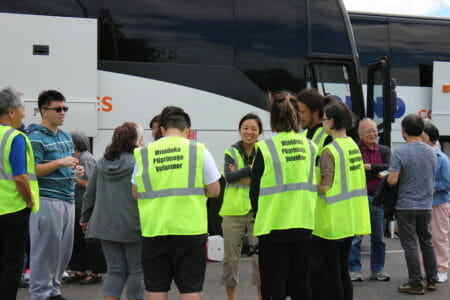 About 250 people participated in the late June journey, traveling by bus, plane and car to Twin Falls, Idaho, near the Minidoka internment camp where thousands of Japanese Americans were incarcerated during World War II. Many pilgrims had lived in the camp as children; others, descendants of those incarcerated, came to honor the memory of family members who were imprisoned here, one of 10 remote incarceration sites established by the United States government in seven western states.
About 250 people participated in the late June journey, traveling by bus, plane and car to Twin Falls, Idaho, near the Minidoka internment camp where thousands of Japanese Americans were incarcerated during World War II. Many pilgrims had lived in the camp as children; others, descendants of those incarcerated, came to honor the memory of family members who were imprisoned here, one of 10 remote incarceration sites established by the United States government in seven western states.
All told, the government implemented a mass incarceration of more than 120,000 Japanese Americans on the U.S. West Coast from 1942 through 1945, after the 1941 Japanese attack on Pearl Harbor when wartime hysteria was at an all-time high. More than half of those imprisoned were children who are now adults, still struggling with the shame and injustice their government visited upon them.
One of those children, Janet Powell of Mount Vernon, Wash., gave voice to a sentiment that echoed throughout the four-day gathering: “This is the first time I have started talking about this, because it’s so terrible to me to talk about it.”
After the war, the Japanese immigrants who were incarcerated never spoke about the years of imprisonment with their children, leaving that generation—and the generations that would follow them—with a significant part of their heritage shrouded in silence, secrecy and mystery.
Satsuki Ina, Ph.D.—“Children of the Camps” producer and a licensed marriage and family therapist who was born in the Tule Lake, Calif., prison camp—encouraged participants in her opening remarks to share their stories, reminding them that the pilgrimage provided “safe space.”
Stories tumbled out of memory. Some were the evocative and impressionistic recollections of children struggling to grasp new external and internal landscapes. Others were sharp, as if fine-tuned through binoculars focused across decades.
Lily Kodama, who journeyed from Seattle’s Bainbridge Island to Twin Falls, was seven years old when FBI agents came to her house and took away her father, leaving her mother with four small children and a farm to care for. Kodama spoke with clarity about her confusion at the FBI’s intrusion into her home and family. Others who watched their fathers being taken away remembered the fear of not knowing where the patriarchs were going or when the family might see them again.
 President Franklin D. Roosevelt’s Executive Order 9066 in February of 1942 gave Japanese Americans just a few weeks’ notice to prepare for leaving their homes, their jobs and businesses—with no idea of where they were going or when they would return. They could take only what they could carry in one suitcase.
President Franklin D. Roosevelt’s Executive Order 9066 in February of 1942 gave Japanese Americans just a few weeks’ notice to prepare for leaving their homes, their jobs and businesses—with no idea of where they were going or when they would return. They could take only what they could carry in one suitcase.
In many areas of the West Coast, the government first corralled them in temporary camps such as fairgrounds, where they lived in stables smelling of urine, because the previous inhabitants had been animals. When permanent camps were ready, trains—with blackout curtains in the windows so travelers couldn’t reveal location information to the enemy—transported Japanese Americans to the wartime camps.
During the pilgrimage, we spent one morning at the Minidoka camp, now a national historic site under development by the U.S. National Park Service. Minidoka was a small city during the war years, surrounded by seven miles of barbed wire fence at one point, with a peak population that approached 10,000. Dusty, dry and arid land, which yielded sagebrush and not much more, was cleared by the imprisoned Japanese Americans, who made the camp self-sufficient in food production in 1944.
Memories came fast and furious at the site. Pilgrims remembered the numbers assigned to the tarpaper-covered barracks buildings where they lived. They told stories of using wooden crates to create vanities. They spoke of the food in communal dining halls and remembered shower and bathroom facilities with no privacy. All mail, outgoing and incoming, they recalled, was reviewed by War Relocation Authority (WRA) personnel who often blacked out portions of correspondence.
The impact of Executive Order 9066 shattered the lives of the imprisoned Japanese and Japanese Americans, ripping from them their homes, livelihoods and families in some cases, not to mention denying their dignity and civil rights. This sweeping arc of injustice was perpetrated by a government “of the people, by the people, for the people.” Clearly for some people, but not others.
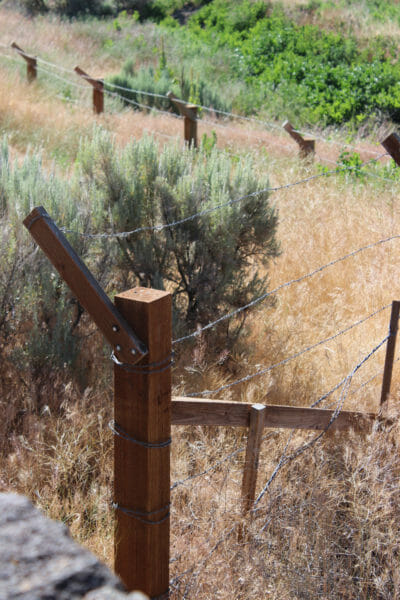 Along with the cultural silence within the Japanese American community which has shrouded this injustice, societal silence has buried the story as well. After all, the Minidoka narrative really doesn’t fit with the story we Americans like to tell ourselves about the greatest country on earth.
Along with the cultural silence within the Japanese American community which has shrouded this injustice, societal silence has buried the story as well. After all, the Minidoka narrative really doesn’t fit with the story we Americans like to tell ourselves about the greatest country on earth.
Who among us wants to face the truth as poet Lawrence Masuda, Ph.D., born in Minidoka, put it during the pilgrimage: “The forced incarceration was like a rape of the community, and the community acted like rape victims.”
It is time to shatter the silence. It is time to tell this story far and wide, so that all Americans know what can happen when fear and hysteria prevail over reason and law. Japanese Americans were imprisoned without trial, without the constitutional protection of due process, in direct violation of the Bill of Rights. It’s time every U.S. citizen understands what happened, because if it happened once, it could happen again.
And therein lies the rub.
“The fragility of civil rights is why this story matters,” said Dale Watanabe, a member of the pilgrimage planning committee and an assistant director of Seattle University’s International Student Center, in the closing ceremony. “This was an unjustly imprisoned community,” he continued, “their lives interrupted by the stroke of a pen from their government. Ours was a community targeted by hate, guilty only because of our ethnicity, the result of years of targeting an immigrant community. [Today] we have public figures promising to build walls to keep out immigrants, suggesting profiling based on religion. It’s another story of targeting immigrants, of racism gone wild.”
If a theme of silence reverberated throughout the pilgrimage, a concomitant commitment to dogged vigilance simmered on the surface as well. “Because it happened to us,” said Masuda, a visiting professor at Seattle University, “we should be the first to stand up when it happens again. America needs to live up to its promise, and we need to remind it of its promise.”
The Minidoka story is, unquestionably, an American story. It’s a story about freedom, or perhaps better put, the lack thereof. It’s a story about ensuring that American values are never breached again.
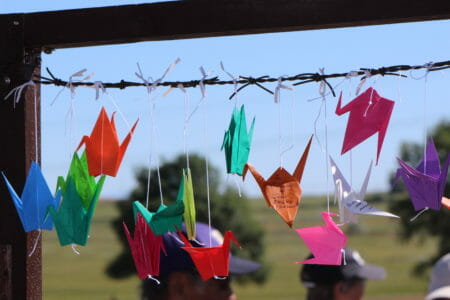 When U.S. President Barack Obama visited Hiroshima, Japan, in May, he remembered the atomic bomb dropped by the United States at the end of World War II: “The memory of the morning of August 6, 1945, must never fade,” he said. “That memory allows us to fight complacency. It fuels our moral indignation. It allows us to change.”
When U.S. President Barack Obama visited Hiroshima, Japan, in May, he remembered the atomic bomb dropped by the United States at the end of World War II: “The memory of the morning of August 6, 1945, must never fade,” he said. “That memory allows us to fight complacency. It fuels our moral indignation. It allows us to change.”
Obama’s words apply to the Minidoka story as well. “We’re not bound by genetic code to repeat the mistakes of the past,” the president said. “We can learn. We can choose. We can tell our children a different story, one that describes a common humanity, one that makes war less likely and cruelty less easily accepted.”
There’s the bottom line. That’s the story we need to come away with. We can learn to be morally indignant. We can choose to be vigilant. We can choose to ensure that the Minidoka story is a lesson, not a model. This is the hope that healing can bring.
Like Hiroshima, the memory of Minidoka is an American story that must never fade, because, as Watanabe said, “There is an America we all want to see.”
And we can make it so.
Susan Gottshall is associate executive director, Communications, American Baptist Home Mission Societies: “This account of the 2016 Minidoka Pilgrimage is dedicated to my good friend, Yosh Nakagawa, with deep gratitude for all he has taught me about being ‘the other.'”
American Baptist Home Mission Societies’ missionaries ministered in the internment camps. Learn about their story in ‘A Church Stands With Its People.’


